#lucanus placidus
Explore tagged Tumblr posts
Text
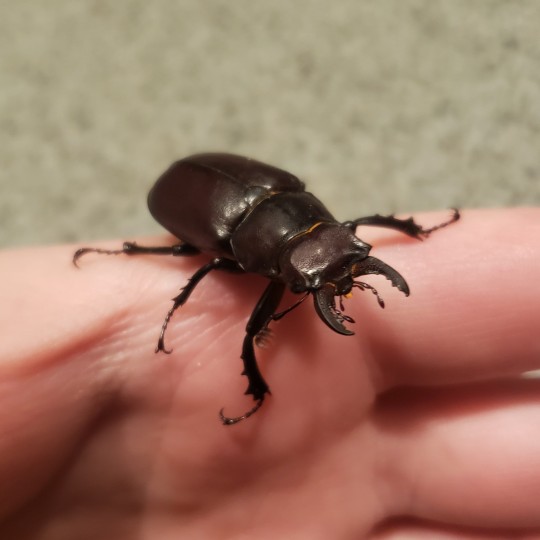

forgot to show yall this fucking enormous Lucanus placidus who invited himself to the bonfire last night
#he was taken inside for pics and promptly released as soon as i could get him off my hand. those little scarab hook feet do not fuck around#i don't actually recommend picking these fuckers up barehanded cause those mandibles aren't pleasant to get nailed by#better than wandering too close to the fire though. idk what it is about scarabs specifically flying/walking directly into the fire pit#i have to command grab june/may beetles out of the air to keep them from immolating themselves upon the flames#lucanus placidus#stag beetle#beetles#bugblr#mine
106 notes
·
View notes
Text










Smooth Black Stag Beetle - Lucanus placidus
I've been going through the backlogs of pictures from prior years and there are a few insect orders that need more attention. They will receive that attention after next week's posts. So before that happens, let's have another look at some of the most wonderful Beetles that make their appearance at the edge of summer. I sincerely hope you enjoy another look at these magnificent creatures and their yearly rituals following their emergence. Their smooth form really does seem to make them pleasing to behold. As they dig their way out from underground in their adult forms, they suddenly find themselves in grassy lawns, on sidewalks, at the bases of trees and within gardens. A majority of the individuals here are male as indicated by their jaw size in widely-opened posture (there's wiggle room for determination of the individual at Picture 9's top left). As such, they're quite eager to start fights with rivals in order to prove their strength and stamina.
Likely many can emerge from one area (as seen in Picture 9) and begin the jaw-fighting competitions to secure mates. They could also fly to a new location if a scent cue were to draw the attention of a hopeful male. When they battle, the Beetles' armor will protect them from any serious damage when engaged with a challenger (insectivores will have strategies around their defenses of course, making these competitions risky in the open). That armor itself is also a challenge itself, as the Stag Beetle must find a way to grip around it, and thusly lift and toss their rival in defeat. For a grounded fight this feat is already tricky, but sometimes these Beetles can take their fights to tree bases and spar while hanging off a vertical surface of bark. Being tossed means a quick trip to the ground, but insect shells are designed to withstand gravity. Defeat may sting, but a Beetle must remain steady while they walk and fly about beneath springtime's sun. Should you get the opportunity to watch Beetle emergence and the results fight, sit and watch.
Pictures were taken on June 3, 2021 with a Google Pixel 4.
#jonny’s insect catalogue#ontario insect#beetle#smooth black stag beetle#lucanus placidus#stag beetle#coleoptera#insect#toronto#june2021#2021#entomology#nature#invertebrates#arthropods#photography#animals
17 notes
·
View notes
Text


Oh hell yeah I love finding these guys in my yard! This lad was in the bird pen, so I picked him up to relocate him to safer grounds.
60 notes
·
View notes
Text


Black Stag Beetles (Lucanus Placidus)
Moved him from the garage and out to nature.
0 notes
Photo

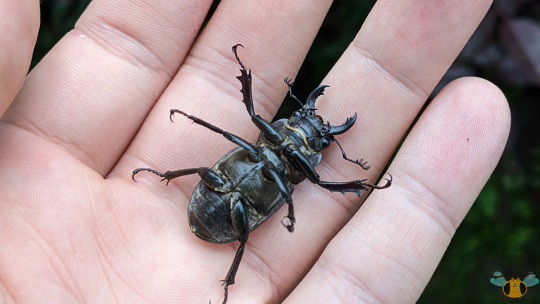

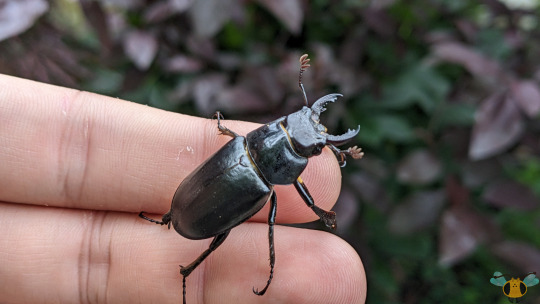


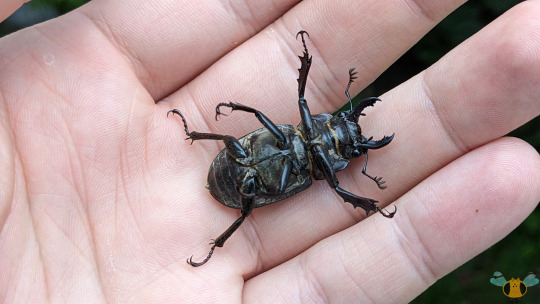



Smooth Black Stag Beetle - Lucanus placidus
It looks like this week has turned into large garden Beetle week! While walking from work, a smooth male specimen was found crossing the sidewalk, and admittedly he was doing so very slowly. They are well equipped to walk, but the additional bulk from their armor takes some getting used to (as can be glimpsed from the many videos found here). With more people following behind me, I picked up this big guy for a closer look and got him of out reach of an errant foot. With mandibles raised, he was ready for a fight but did not bring one against my finger when they were lightly poked (disclaimer: please don’t prolong annoyance to any Beetles). He flipped over of his own accord while exploring my hand, hence the pictures of his magnificent underside and a chance to closely examine how each pair of legs connects to the abdomen. Moreover, it can be seen that each pair of legs are structured differently than the other. The front legs are covered in armored spikes, while the back legs have altered curvature to better move and slide beneath the abdomen.
Each leg extends from the tibia to a slim, flexible tarsus and ends with a grappling-hook like claw (known as a pretarsus). As would be expected, those tarsal claws are handy when climbing up surfaces and for gripping terrain, but against human skin they won’t slash at all. At most, they’ll tickle. When flipped, he didn’t flail those legs around very much, nor his body in attempt to re-orient to the right way up (my hand tilted to flip him back to normal) which is most strange. Generally the Beetles I’ve seen go mad when flipped over and use any means at their disposal to right themselves. When a Stag Beetle exposes their soft underbelly to nature, it can be a death sentence since they’d be put in a position where their armor couldn’t protect them. An exposed underside is also the ultimate defeat when males fight each other, aiming to grip and flip each other with their curved, toothed mandibles. It sounds a little silly, but it’s no easy feat to grab a rival by your mouth, hoist them above your head, carry them and then flip them over! The mandibles are big help of course, and while they are the most prominent mouthparts, smaller mouthparts are beneath the head to manipulate sap and vegetation into the insect’s mouth.
Pictures taken on June 15, 2023 with a Google Pixel 4.
#jonny’s insect catalogue#ontario insect#beetle#smooth black stag beetle#lucanus placidus#stag beetle#coleoptera#insect#toronto#june2023#2023#entomology#nature#invertebrates#arthropods#animals#photography
29 notes
·
View notes
Text
Jonny's Insect Catalogue - Now on YouTube
As mentioned in my 5 Year Anniversary post showcasing a colony of Small Yellow Ants, the blog's reach has been expanded to YouTube as I've created a channel that will host insect videos. If you are interested in insects or nature content, I will see you there!
Please note: any advertisements placed on my YouTube uploads are not of my doing. The intention with my channel and the videos there are to showcase the insects I've observed, not to incessantly bombard you with ads.
With the channel up and running, all the videos featured in this blog’s Video Catalogue will eventually be uploaded there without any caveats. Videos that were previously trimmed or separated into multiple parts will be shown in full. Furthermore, the intent is to upload them chronologically, beginning with every video currently uploaded to this blog. I may jump around a bit, especially if I find an amazing insect to share.
New videos will be uploaded every Sunday, creating the following upload schedule for this blog: Tuesday (Tb) >> Friday (Tb) >> Sunday (YT). For additional information, please refer to the YouTube info section of the blog. If you have any further questions, I'm happy to answer them.
The rest of this post will speak briefly on the channel's welcome video (playing above), the channel's outro video and the first insect upload that will grace the channel. I hope to see you in the world of video content creation. Also, I apologize in advance for any audio "pops" heard in earlier recorded videos (particularly those from 2017-2019). Audio for those videos will be cleaned up best as possible before they are uploaded.

The Channel Welcome video is intended to showcase a glimpse into the content that has been on this blog for 5 years. To keep with the natural feel, the background audio was created using the sounds from the following videos: Asian Ladybug Pupa, Cicada Hatching, Potter Wasp. Ironically, though my channel is focused on insects, the Welcome audio primarily features birds. They may like to eat insects, but they provide some of the best and most recognizable natural ambience sounds! As the video approaches the end, there's also a bit of the outro audio when the logo appears...

The channel's video outro audio was created by layering the sounds of the insects in these videos into one track: Black-Legged Meadow Katydid, Brown-Belted Bumblebee, Eastern Carpenter Bee, Cicada Hatching. It was a challenge to synchronize the sounds to the text, but everything gradually clicked together. The outro features the famous slogan for creating a YouTube community, "Like, Share, Subscribe", and of course "Thank you for Watching". I do sincerely mean the latter, thank you! Shorter videos will use a truncated version of the outro since it doesn't make sense to have the video's outro longer than the video itself (haha).


When I originally created the thumbnails for the videos on this blog, I chose the film strip since it holds strong iconography with visual media and movies. It also held potential to be stylized and clean, as if to show the best possible glimpse into the life of the recorded insects. Little did I know that 5 years later I would join them together to create film reel styled graphics for the channel's banner. The image on the left is my first draft, and the image on the right is the final draft currently in use. I didn't want to change the dimensions and content, but the image had to fit YouTube's TV and Desktop parameters. I couldn't bare to junk the original file, so I have included in my channel's welcome video before the insect showcase, and it's featured on the blog in a few places.
All text and image graphics used in my video will be created in photoshop. The videos will be compiled together using Clipchamp. Although it has a bit of lag during playback, slow finishing export and a cluttered UI, I can make it work.
Finally, the first insect video to official grace my YouTube channel will be the Monarch Butterfly I found emerging from its Chrysalis after a few days of careful observation. It's the video I'm most proud of and it showcases something truly special in the insect world. On YouTube, it has a duration of 4:46 compared to 50 seconds here (it had to be trimmed due to size limitations). I'm honored to finally show it in full. Please see for yourself: Monarch Butterfly - Emerging from its Chrysalis.

Thank you to all my followers, readers, friends and family for your support and for viewing these insects. Every one of you mean the world to me. The journey into the insect world continues!
This post also represents a serendipitous milestone: 100 video posts uploaded to this blog! Here's to 100 more featuring many amazing insects!
#jonny’s insect catalogue#ontario insect#video#insect#blog announcement#youtube#youtube channel#milestone#butterfly#beetle#caterpillar#ant#fly#hoverfly#swallowtail butterfly#stag beetle#pavement ant#bumblebee#katydid#cicada#milkweed beetle#dog day cicada#eastern black swallowtail#brown belted bumblebee#smooth black stag beetle#transverse hoverfly#monarch butterfly#monarch butterfly chrysalis#monarch butterfly caterpillar#lucanus placidus
1 note
·
View note
Text



Lucanus placidus
#excuse the fuzz she had just been rescued from inside a school and wouldn't sit still for me to get the rest off#which is fair cause she's a small invertebrate and i'm a giant ape with tweezers#mine#bugblr#lucanus placidus#stag beetle
308 notes
·
View notes
Text


made some friends (Lucanus placidus) at the bonfire tonight

#literally none of us even knew there were stag beetles in the area and everyone other than me was raised here#i was so fucking excited i've not had this much enrichment in months#lucanus placidus#stag beetle#(they don't have a common name that i'm aware of)#mine#bugblr#don't roast my fruity little hoodie
27 notes
·
View notes
Text


there were hundreds of them btw. cruising for bussy (beetle pussy)
#some of them looked recently eclosed too and the property owner was like wtf i've never seen those before#mine#bugblr#lucanus placidus#stag beetle
8 notes
·
View notes
Photo
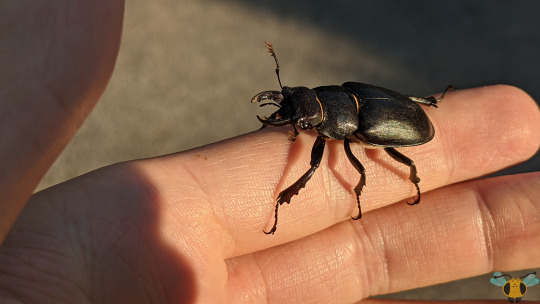
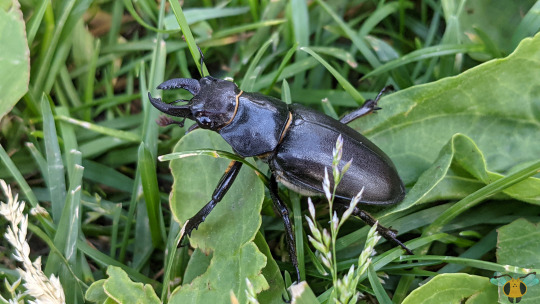

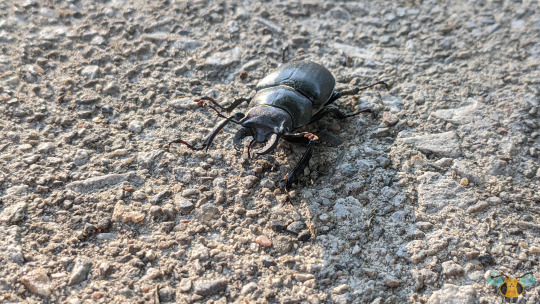
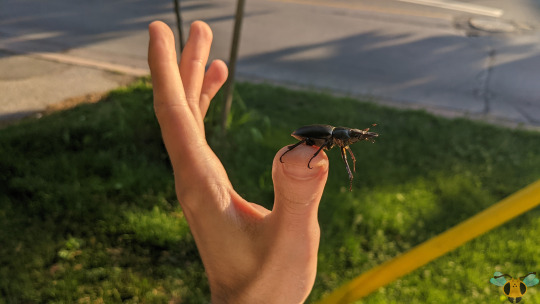

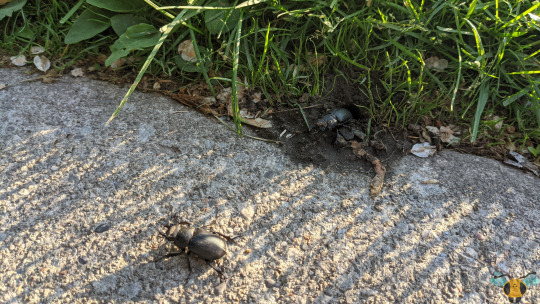
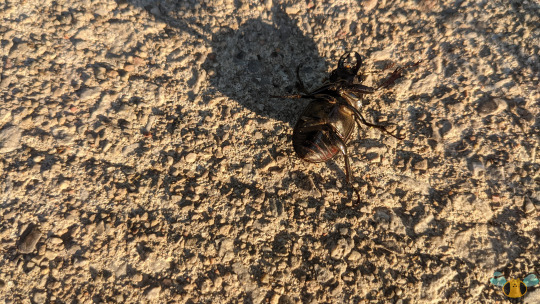
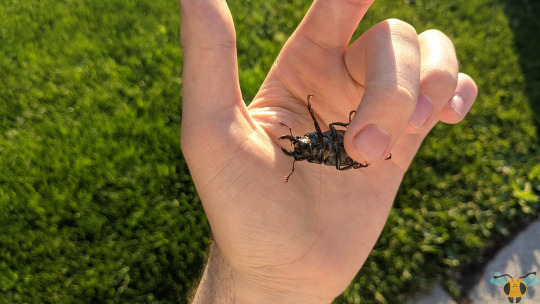

Smooth Black Stag Beetle - Lucanus placidus
As promised from last week, today we have a showcase and little more of an in-depth look at this specie of Stag Beetle with several individuals having emerged from their pupation. First seen in these 2 video posts that showcase their movement and shape, now we dive into a photo showcase. Since these Beetles are quite large in terms of size (especially for a temperate insect) their details and intricacies become much more visible, especially with the available equipment. For a view rarely seen, Pictures 8 and 9 are recommended to view the underside of the insect*. True to their name, their carapaces are smooth, free of ridges, grooves and patterning. In Ontario, that is the piece of information that can help distinguish this insect from the Antelope Beetle, a fellow Stag. Moreover, while they look imposing with their size and large mandibles, remember that is posturing and their jaws can do little to hurt you. Look at those jaws carefully: a close north american relative (L. capreolus - The Reddish-Brown Stag Beetle) is very similar to this Beetle. However, today’s insect features mandibles will multiple small teeth, while the Reddish-Brown Stag has mandibles with only one extra point. If you wish to pick them up for a closer look you certainly can, but do so gently, grabbing from the sides and lifting them carefully. If you do, they don’t hesitate to climb around a hard and investigate.
Like other insects, they use their tarsal claws which make climbing no issue for them. Claws may sound intimidating, but rest assured their claws do little more than tickle or slightly pull as they walk. They are good for what they’ve been honed to do: pull them across leaves, grass and to climb out of the ground after emerging from their pupa. Picture 7 showcases this nicely, with a fresh adult joining the world. For the most part the Beetles largely seem passive with each other’s presence (there were 4 in this area), but (as seen in Picture 10) they will posture and open those jaws to try to intimidate their rivals and dissuade a confrontation. All bets are off of course if mating competitions begin. Though the males can use their jaws to grip and flip their fellow Beetles, the strength of this specie come from the jaws alone. Take note of their legs! Pictures 5 and 9 showcase the Beetle’s ability to remain gripped even while half their body is off a surface and while hanging upside-down respectively. Magnificent! And yet just a taste of strength! It’s that grip, power and maneuverability that allows the Beetles the leverage to flip their foes, even if heavy and clad in armor! When I say maneuverability, I’m strictly referring to the legs and body when anchored, as normally their armor and side make them relatively slow to move and run.
*Note: While temporarily flipped over, I flipped the Beetle right side up again after taking pictures. Though they appear helpless these Beetles can right themselves up with some effort by themselves.
Pictures were taken on June 3, 2021 with a Google Pixel 4.
#jonny’s insect catalogue#ontario insect#beetle#smooth black stag beetle#lucanus placidus#stag beetle#coleoptera#insect#toronto#june2021#2021#entomology#nature#invertebrates#arthropods#photography#animals
6 notes
·
View notes
Video
tumblr
Smooth Black Stag Beetle - Lucanus placidus (Part 2)
My goodness me, prepare for a Beetle bonanza!! Finally, these beautiful Beetles can be showcased on this blog in all their armored glory. Consider this a small taste of what’s to come; there will be photos uploaded next week. Here we find a gathering of Stag Beetles having emerged from their pupation to enjoy the summer. Though peaceful, they can still use those jaws to bite if they need to. Fortunately, they aren’t really designed to bite and pinch, but rather to grip and hold (in the attempt to flip). This more so goes for the male Stag Beetles whose horns tend to be longer and more elaborate than the female horns. With these Beetles, it can be hard to tell which are male and female, but if you look closer you can find your answer (jaws and size). You may want to pick them up to get a closer look, but if you do, handle them with care. Since their jaws are in the front, grab them gently from the sides and place them in your hand with room to move. Though they may open their jaws while in your palm, this is merely posturing and intimidation (possibly for other males). This certainly looks imposing! It also makes for a good photography session.
Video was recorded on June 3, 2021 with a Google Pixel 4. Due to Tumblr’s video size restrictions, this video has been split in two. Click here for Part 1. You can also find this video on YouTube now (in full with Part 1) as of January 19, 2025.
#jonny’s insect catalogue#ontario insect#beetle#smooth black stag beetle#lucanus placidus#coleoptera#stag beetle#insect#video#june2021#2021#toronto#entomology#nature#invertebrates#arthropods#photography#animals
0 notes
Video
tumblr
Smooth Black Stag Beetle - Lucanus placidus (Part 1)
My goodness me, prepare for a Beetle bonanza!! Finally, these beautiful Beetles can be showcased on this blog in all their armored glory. Consider this a small taste of what’s to come; there will be photos uploaded next week. Here we find a gathering of Stag Beetles having emerged from their pupation to enjoy the summer. Search around on your lawn if you find some and chances are you’ll find holes from their emergence. If you’re not hearing Cicadas, it’s Stag Beetles. Their large bodies are well protected with armor, but all that weight might make flying a challenge and can make walking through grass cumbersome. Nevertheless, they can get where they need to go and find mates. The larger jawed males will fight each other for the chance to mate, but otherwise they largely seem indifferent to each other. When you have armor like that, I suppose there’s little reason to fear a fellow Beetle aside from being flipped over. If you find some Beetles, consider yourself lucky. Hang around and see if they begin the rumble with each other, it’s quite the spectacle.
Video was recorded on June 3, 2021 with a Google Pixel 4. Due to Tumblr’s video size restrictions, this video has been split in two. Click here for Part 2. You can also find this video on YouTube now (in full with Part 2) as of January 19, 2025.
#jonny’s insect catalogue#ontario insect#beetle#smooth black stag beetle#lucanus placidus#stag beetle#coleoptera#insect#video#toronto#june2021#2021#entomology#nature#invertebrates#arthropods#photography#animals
0 notes
Photo

Smooth Black Stag Beetle - Lucanus placidus
For today’s specimen, it was found while I was in a bit of rush. However, there’s always time for at least one picture, especially for a Stag Beetle! Unfortunately, this Beetle wasn’t alive when I found it (or at the very least, was barely moving), and it was just sitting on the sidewalk. Moreover, the wind blew it onto its side when the picture was take. I suppose that does allow for the showcase of the dorsal side of the insect along with a clear view of the comb-like antennae (so maybe it was a good thing). In any case, I placed the Beetle in nearby grass after the picture and then hurried off! Whatever its condition, its a lovely specimen, and probably a female Stag Beetle given the size of the mandibles (more on that below). This Beetle doesn’t have a common name, so I’ve given it one for this blog; hopefully I can find more live Beetles in the future to better document this specie. As mentioned above, this Beetle is most likely a female given the size of its mandibles as males tend to have larger ones used for competition for mates.
However, compared to other Beetles with more exaggerated horns and jaws, the difference in mandible size isn’t as drastic (I’d say it’s similar to the Antelope Beetle - Dorcus parallelus). While this female has smaller, more blunted jaws, males have jaws that sport multiple tooth-like protusions, which can be helpful during identification as this Beetle can be confused with another Ontario resident: the Reddish-brown Stag Beetle - Lucanus capreolus (whose males have only a single jaw tooth). Something else to be aware of: L. placidus and L. capreolus can appear in differing shades of brown and black, irrespective of what their common name may describe, so you’ll need to look at other details to successfully identify them. Best way to tell them apart: their legs. Today’s specimen has legs that are uniformly dark (some accounts say dark reddish-brown, others black) while Lucanus capreolus has brownish, bi-colored legs. It’ll make a lot more sense when you compare the two, but try to use all the knowledge available when working to successfully identify a specie. In retrospect, I probably could’ve collected the Beetle to examine it further, but it wasn’t to be. Hopefully the specie can be found again in the future!
Picture was taken on June 12, 2018 with a Samsung Galaxy S4
#jonny’s insect catalogue#ontario insect#beetle#lucanus placidus#smooth black stag beetle#stag beetle#coleoptera#insect#toronto#june2018#2018#entomology#nature#invertebrates#arthropods#photography#animals
0 notes